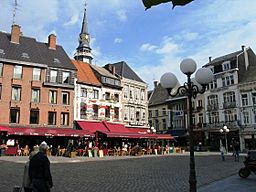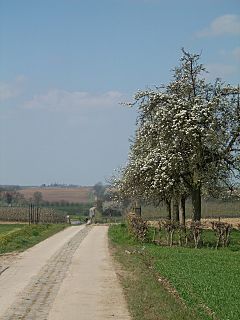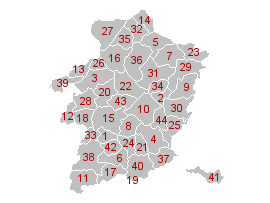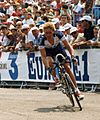Limburg (Belgium) facts for kids
Quick facts for kids Limburg |
|||
| Province of Belgium | |||
|
Great Market place in Hassel.
|
|||
|
|||
| Country | |||
|---|---|---|---|
| Region | |||
| Capital | Hasselt | ||
| Highest point | Remersdaal | ||
| - location | Voeren, Tongeren, Limberg | ||
| - elevation | 287.5 m (943 ft) | ||
| - coordinates | 50°43′53.51″N 5°52′51.05″E / 50.7315306°N 5.8808472°E | ||
| Area | 2,414 km² (932 sq mi) | ||
| Population | 867,413 (1 January 2017) | ||
| Density | 359 /km² (930 /sq mi) | ||
| Subdivisions | 3 Arrondissements 44 Municipalities |
||
| Governor | Herman Reynders | ||
| Timezone | CET (UTC+1) | ||
| - summer (DST) | CEST (UTC+2) | ||
| Postal codes | 3500–3999 | ||
| ISO 3166-2 | BE-VLI | ||
Limburg is a province in the eastern part of Flanders, which is one of the main regions of Belgium. Its capital city is Hasselt.
Contents
Geography of Limburg
Limburg is located west of the Meuse River. It shares a border with a province in the Netherlands that is also called Limburg. To the south, it borders the Walloon province of Liège, with which it also has a shared history. To the north and west, Limburg borders other Belgian provinces like Flemish Brabant and Antwerp, and the Dutch province of North Brabant.
The province of Limburg covers an area of about 2,414 square kilometers (932 square miles). It has a population of over 800,000 people. The province is divided into three main areas called arrondissements, which contain 44 different towns and villages, known as municipalities.
Some important municipalities include Hasselt, which is the current capital. Borgloon was an important capital in the early Middle Ages. Genk is another big city, and Diepenbeek is home to Hasselt University. Tongeren is special because it's the only Roman city in the province and is considered the oldest city in Belgium.
A unique part of Limburg is the municipality of Voeren. It's a separate piece of land, like an exclave, meaning it's not connected to the rest of Limburg or Flanders. It's surrounded by the Netherlands to the north and the Walloon province of Liège to the south. This area became part of Limburg after some changes in 1977.
The highest point in the province is 287.5 meters (943.2 feet) high. It's located in the town of Remersdaal, which is part of the Voeren municipality.
The central part of Belgian Limburg has two important waterways running through it from east to west: the Demer river and the Albert Canal. The Demer river collects water from most of the central and southern parts of the province. In the southeastern corner, the Jeker river flows past Tongeren and into the Maas River in Maastricht. The Maas River, which starts in France, forms the eastern border of the province and collects water from the northern part of Belgian Limburg.
Administrative Divisions
The province of Limburg is divided into 3 main districts, called arrondissements: Hasselt, Maaseik, and Tongeren. These districts contain a total of 44 municipalities (towns and villages).
| Hasselt | Maaseik | Tongeren |
|---|---|---|
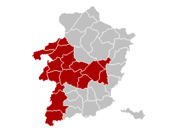
|
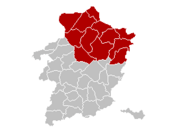
|
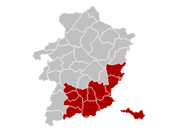
|
Population by Arrondissement
Here's how the population has changed in each of Limburg's districts over several years:
| Arrondissement | 01-07-2003 | 01-07-2004 | 01-07-2005 | 01-07-2006 | 01-01-2010 | 01-01-2012 |
|---|---|---|---|---|---|---|
| Hasselt | 389,171 | 391,124 | 393,460 | 396,403 | 408,370 | 414,401 |
| Maaseik | 223,335 | 224,622 | 225,770 | 227,245 | 232,735 | 235,305 |
| Tongres | 191,386 | 191,809 | 192,732 | 193,558 | 197,400 | 199,698 |
| Province of Limbourg | 803,892 | 807,555 | 811,962 | 817,206 | 838,505 | 849,404 |
Related pages
- Limburg (Netherlands), a province in southeastern Netherlands.
Images for kids
-
Statue of Ambiorix in the main square of Tongeren.
-
Map showing the two contemporary provinces called Limburg, (the red one in Belgium, and the brown one in the Netherlands), as well as the medieval Duchy they are both named after. Only the villages of Teuven and Remersdaal in Voeren, part of modern Belgian Limburg only since 1977, were in both modern and medieval Limburg.
-
Main Market Square of Sint-Truiden with Town Hall and Church.
See also
 In Spanish: Provincia de Limburgo (Bélgica) para niños
In Spanish: Provincia de Limburgo (Bélgica) para niños


